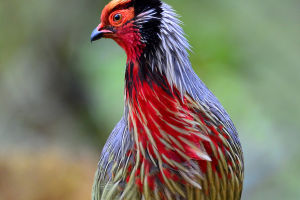In the vast world of nature, there is an eye-catching bird named Kingfisher. The kingfisher is elegant and nimble with emerald green feathers. It is a symbol of freedom and beauty. Today, let us walk into the world of the kingfisher and explore its refreshing flight journey.
The kingfisher is a small bird that lives mainly in forests and jungles in tropical and subtropical regions. Their wings are slender and sharp, suitable for high-speed flight and deft turns. The feathers of the kingfisher are bright green, like the most precious gemstone in nature, giving people a feeling of freshness and vitality.
This unique feather coloration is due to special pigments and structures within the kingfisher's body. When the sun shines on them, the kingfisher's feathers shimmer with a charming light, like a green lightning bolt piercing the blue sky.
Kingfishers are famous all over the world for their excellent flying skills. They can travel through dense forests at extremely high speeds, and shuttle lightly through the gaps between the trees. Kingfishers fly gracefully and uniquely, often putting on a series of astonishing aerial displays.
They are able to perform difficult maneuvers such as sharp turns, spiral descents, and vertical ascents in flight, which is amazing. The flexibility and agility of the kingfisher in the air are unmatched by other birds, which also makes it an elf-like existence in nature.
In addition to their excellent flight abilities, kingfishers are also known for their diverse and unique calls. Each species of kingfisher has its own unique song, from soft calls to loud calls, each of which is refreshing. These wonderful sounds often resound through the forest at dawn and dusk, adding a touch of mystery and vitality to nature.
Kingfishers feed mainly on insects and other small invertebrates such as cicadas, dragonflies, butterflies, insects on spider webs, etc. They use keen vision and agile flying skills to catch their prey. Kingfishers will usually wait on a branch before swooping down quickly to hunt.
Kingfishers are usually monogamous, choosing a mate to live with. They build their nests in tree hollows or on soil walls along river banks. Nests are usually constructed from materials such as leaves, twigs, and bark. The female bird is responsible for incubating the eggs, while the male bird is responsible for providing food for the female bird. Kingfisher breeding season varies from region to region.
Some kingfishers form small flocks, while others tend to be more solitary. They are usually solitary birds but may form some social groups during the breeding season. Some kingfishers make short migrations, while others migrate within their habitats in search of better food and breeding conditions.
However, in the face of increasingly serious ecological threats, the living environment of kingfishers is being threatened. Factors such as deforestation, habitat destruction, and climate change have all negatively impacted the kingfisher's survival. Therefore, the protection of kingfishers and their habitats has become particularly important.
Each of us can do our part in the cause of Kingfisher conservation. By supporting and participating in organizations that protect kingfishers, we can raise awareness and concern for kingfishers and drive more conservation action.
In addition, we can also actively participate in forest protection and environmental protection activities, reduce deforestation and destruction of forests, and provide a safe and healthy living environment for kingfishers.
Kingfishers are gifts of nature that captivate us with their beauty and freedom. Let us work together to protect these beautiful creatures and ensure that they continue to soar, delight and amaze us for generations to come.
Let the kingfisher become a green messenger flying freely in the sky, guarding the treasures of nature, and always conveying the beauty and hope of life.


